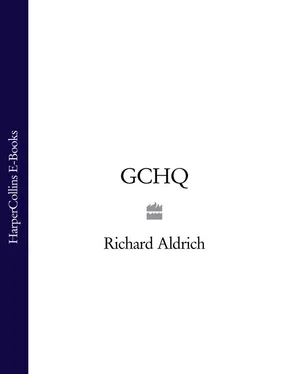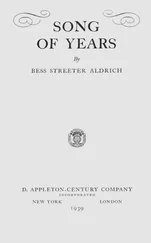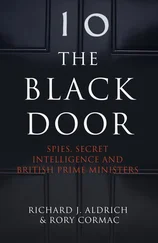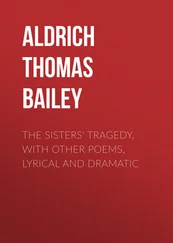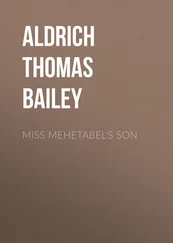Success in the exciting new field of elint offset some recent disappointments. GCHQ and its American partners had not yet recovered the medium-grade Soviet cyphers lost during the infamous ‘Black Friday’ of October 1948. They had not detected the advent of the first Soviet atom bomb, nor had they anticipated the outbreak of the Korean War. However, the elint effort against the Soviet Air Force, which also involved direction-finding and traffic analysis, was one of the key areas in which GCHQ could claim outstanding achievement in the first postwar decade – and it was sustained.
There was an especially secret reason why GCHQ and NSA examined the operational anatomy of the Soviet ‘nuclear bear’ so minutely. During the early 1950s, target intelligence officers in London and Washington had been busy exchanging sensitive data on ‘the mission of blunting the Russian atomic offensive’. This meant planning early counter-force attacks against Soviet nuclear forces, especially bombers, in the hope of destroying them on the ground in Eastern Europe before they could be used in a future war. GCHQ had given particular attention to this matter because of the vulnerability of Britain, and the Americans were impressed by the progress London had made on it. GCHQ and the RAF’s secret units had amassed ‘a significant amount of evaluated intelligence, particularly in the special intelligence field, which would be of the greatest value’ if war broke out. 38
American officers considered that ‘vigorous efforts should be taken immediately to ensure rapid development of a joint research program to insure maximum exploitation of the British resources’. In short, it was not just the raw elint that the British had collected, but their sophisticated analysis of it that allowed it to be turned into high-quality finished intelligence, a legacy of the skills garnered during Bletchley Park’s Hut Three operation. Most of the airfields and the operational procedures for the Soviet Union’s nuclear air force in the European theatre had been mapped by 1952. 39 In June of that year a team from the US Air Force Security Service centre at Brooks Field, led by Major Hill, visited GCHQ and one of its outstations at Knockholt in Kent to further converge their activities in this area. Hill also wanted to discuss the creation of new ‘ground-based electronic intercept stations’ in Europe. Korea had greatly accelerated preparations for a ‘hot war’, and GCHQ’s elint success on Soviet air defences helped it to justify budget increases. 40
Throughout 1951 and 1952, global war often seemed imminent. Communist China had entered the Korean War in 1951, and numerous Soviet advisers were busy assisting the North Korean forces. Soviet and American pilots were actually fighting each other in the skies of East Asia. Although the public were never told, sigint made this fact clear to the secret listeners. In this increasingly fevered atmosphere, improved intelligence was given a high priority. On 22 January 1952 the British Chiefs of Staff met the Permanent Under-Secretary of the Foreign Office to review plans for accelerating intelligence. GCHQ was given a large tranche of new money over five years under the heading ‘Methods to Improve’. Its extensive shopping list included larger computers and ‘high speed analytical equipment’ for renewed attacks on high-grade Soviet communications. These were given the highest priority, and government research and supply elements were instructed accordingly. GCHQ and the Admiralty were beginning a new programme to build better receivers for ground-based and seaborne ‘Technical Search Operations’ which were critical to elint. Again, much of this was about targeting, and the Chiefs of Staff continually reiterated the ‘very great importance’ of speeding up technical development in these areas. 41 By November 1952, British defence chiefs wanted increased expenditure on intelligence, and were unanimous that in the short term the emphasis should be on sigint. 42
Late 1952 was an exciting time for GCHQ. Equipped with a larger budget, staff had begun to move to their new headquarters at the twin sites in Cheltenham. It also had a new Director, Wing Commander Eric Jones. Given the rise of airborne sigint, it was appropriate that an RAF officer should have succeeded Edward Travis, who had been increasingly ill during the late 1940s with lumbago. 43 Jones was a Bletchley Park veteran who had proved himself while in charge of the critically important Hut Three. Bill Millward, another long-serving GCHQ veteran, recalls that at first glance ‘his qualifications for the post were not apparent’. He had spent the 1930s as a cloth merchant in Macclesfield. However, he was a quick learner, a natural diplomat and a man of obvious principle. 44 He had proved an excellent liaison officer in Washington towards the end of the war, and after the ‘happy outcome’ of the BRUSA conference of 1946 he had decided to ‘stay in the racket’. 45 This was good for GCHQ, since Jones proved to be a leader who inspired instinctive trust. In late 1952 he was busy filling the three hundred extra staff posts recently authorised. GCHQ had already proposed an additional increment of a further 366 staff, and was going from strength to strength. 46
In the late summer and the autumn of 1952, senior GCHQ officers like John Somerville had been pressing defence scientists and intelligence chiefs to join them in planning the future expansion of airborne sigint. 47 Good results were being obtained, and GCHQ was making the most of the facilities at its disposal, but there were just not enough ‘ferret’ flights, and the elint-collection effort needed ‘more equipment, personnel, aircraft and ships’. 48 The RAF was using its three RB-29 Washingtons, which were big enough for the increasingly complex equipment required. 49 It was a Washington that had captured the first recordings of ‘Scan Odd’, the new airborne radar which equipped Soviet fighters. However, the RAF’s Washingtons were slow and vulnerable compared to the upgraded American variant, which could reach 400 mph, as fast as a wartime fighter. 50 British elint specialists longed to enter the jet age with the military version of the de Havilland Comet, but there seemed to be no hope of getting this desirable aircraft. Part of the problem was that 192 Squadron was not seen as a front-line fighting unit, tended to be overlooked and was continually moved between commands over the next two decades. 51 There was also an acute shortage of staff at GCHQ qualified in the rarefied field of elint analysis, which was made worse by the upheaval of the move to Cheltenham. 52
The required extra momentum came from the Americans. Washington pressed the British for more spending and more effort at a major US/UK elint conference in December 1952. 53 Accordingly, in 1953, Britain’s elint specialists acquired more small specialist Canberra jet aircraft, and a year later, after much discussion, the Treasury reluctantly approved the purchase of three much-prized de Havilland Comet C2s, a modified version of Britain’s first jet airliner. Until now, all of the sigint aircraft had been rough-and-ready adaptations. The Comet C2 was Britain’s first dedicated airborne sigint platform designed from scratch. In the spring of 1957 the first C2 arrived at CSE Watton and was placed in the hands of SRIF, the RAF’s secret team of sigint engineers, who were based in No.3 Hangar. Their task was to cram a whole mini-sigint ground station into the cramped interior of an airliner. For George Baillie, the Principal Scientific Officer at Watton, this was the most complex task his team would ever undertake. Equipping the three Comets was extremely expensive and time-consuming. It was therefore with complete horror that they discovered a fire in No.4 Hangar in the early hours of the morning of 3 June 1959. One plane was completely destroyed, leaving CSE with only two Comets to fulfil the many missions requested by GCHQ. The Treasury boggled at the cost of the unscheduled replacement of the third aircraft, and it was two years before GCHQ’s Deputy Director Joe Hooper persuaded it to find the money. 54
Читать дальше
